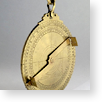
Highly versatile instruments, astrolabes could also be used to tell the time by day or by night, based on direct measurement of the height of the Sun or of a star. Astrolabes had been developed to the highest levels by medieval Islamic astronomers. In the 16th century, devices of European design were produced for measuring time by night. Nocturnals, for instance, determined the hour by the position of the last two stars in the Big Dipper in relation to the Pole Star. These instruments were useless when the sky was overcast.
Astrological disk
Inv. 2505
Maker unknown, 17th cent.
Astronomical compendium
Inv. 2478
Maker unknown, German, late 16th cent.
Astronomical compendium
Inv. 2481
Maker unknown, German, ca. 1600
Geometrical square
Inv. 121
Maker unknown, Italian?, 16th cent.
Hourglass (sand)
Inv. 429
Maker unknown, Italian?, 17th cent.
Lunar converter
Inv. 3701
Maker unknown, Italian, 17th cent.
Nocturnal
Inv. 2504
Maker unknown, French, 1560
Nocturnal
Inv. 2494
Maker unknown, Italian, late 16th cent. - early 17th cent.
Nocturnal
Inv. 2493
Maker unknown, Italian, mid-17th cent.
Nocturnal
Inv. 2501
Maker unknown, French, 1554
Nocturnal
Inv. 2502
Pineau [attr.], French, ca. 1600
Octant
Inv. 120
Maker unknown, Italian?, 16th cent.
Oil clock
Inv. 3570
Maker unknown, 18th cent.
Perpetual calendar
Dep. MA, Firenze
Christian Boyling, Dresden, second half 17th cent.
Plane astrolabe
Inv. 1096
Hans Dorn [attr.], German, 1483
Plane astrolabe
Inv. 1106
Maker unknown, German?, 16th cent.
Plane astrolabe
Inv. 1107
Maker unknown, French?, 13th cent.
Plane astrolabe
Inv. 1109
Maker unknown, Arab, 14th cent. (?)
Plane astrolabe
Inv. 1105
Muhammad 'Ibn Abi'l Qasim 'Ibn Bakran, Arab, 1102-1103
Plane astrolabe (open)
Inv. 1111
Georg Hartmann, Nuremberg, 1545
Portable quadrant
Inv. 2513
Maker unknown, 17th cent.
Portable quadrant
Inv. 2513
Maker unknown, 17th cent.
Quadrant
Inv. 1495, 2465
Tobias Volckmer, Braunschweig, 1608
Quadrant with Easter scale
Inv. 2518
Josua Habermel [attr.], German, ca. 1600

































